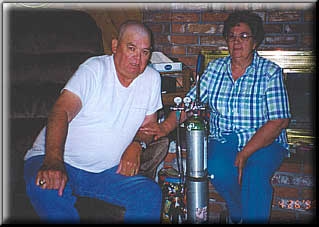Plumber Tells The Grim Reaper To Get Lost
In February 1999, Mr. Gilcrease became short of breath. After about a week of this, he went to St. Mary's Hospital in Walla Walla, Washington. A chest x-ray showed a pleural effusion. The hospital attempted a thoracentesis to remove the fluid, but this was unsuccessful. So Mr. Gilcrease was prescribed an antibiotic, Biaxin, and discharged. Mr. Gilcrease may have been allergic to the Biaxin, because it made him itch constantly, but it did not help his shortness of breath.
Instead, over the next two days, he became more and more short of breath and fatigued. He also developed a low grade fever and a slight cough. So he went to the emergency department of Good Shepherd Community Hospital in Hermiston, Oregon on February 19. This time, the thoracentesis was successful, pleural fluid was removed, and Mr. Gilcrease felt better. He was sent home with another prescription for oral antibiotics.
By February 25, Mr. Gilcrease felt worse again. He was admitted to the hospital, and put on intravenous antibiotics and on oxygen. Another chest x-ray showed that the pleural effusion on his right side had increased. Mr. Gilcrease had a chest tube inserted and almost a liter of straw-colored fluid drained out. A follow up x-ray showed, for the first time, a "curious density" in Mr. Gilcrease's lower right chest.
Over the next week, Mr. Gilcrease's chest tube was removed, repositioned and replaced; and he endured a bronchoscopy with washings, and several CT scans. The doctors were still unable to determine the cause of the pleural effusion. Finally, the doctors performed a thoracoscopy and took a pleural biopsy. Mr. Gilcrease was tentatively diagnosed on March 8 with diffuse mesothelioma, epithelioid type. The biopsied tissue was sent to USC Clinical Laboratories for immunohistologic consultation. Based on the reactions of a panel of specific cell markers to the biopsied tissue, USC confirmed the mesothelioma diagnosis on March 15, 1999.
Fred and his wife Dorothy soon learned the grim facts about mesothelioma survival rates. According to Fred, who was then 62 years old, it was like finding out he had a death sentence; he just didn't know when it would be carried out.
But Fred and Dorothy did not give up hope. Under the care of their doctor, Stephen Iacoboni, at the St. Mary Medical Center in Walla Walla Washington, Fred began chemotherapy on March 19, 1999. This was just days after the diagnosis was confirmed. Chemotherapy has been hard. The treatments leave him weak, disorientated and sick for the first few days.
But the chemotherapy regimen administered by Dr. Iacoboni appears to be helping. Fred received Taxol and Carboplatin chemotherapy from March to August, 1999. This seemed to retard the advance of the tumor all the way up to April, 2000. In April and May, 2000, Fred successfully completed another three cycles of chemotherapy. He is now in a watchful waiting mode. He is in no hurry to return to the doctor's office -- although lately the news has been much brighter than the news he got the first time he was told he had mesothelioma.
Fred is grateful to Dr. Iacoboni, who does not hold himself out as an expert in mesothelioma. He is not part of a prestigious hospital and he does not travel the world giving lectures or consulting with mega-drug companies. But he does care deeply about his patients and works hard to give them a reason to keep fighting. Fred feels fortunate to be here and he looks forward to seeing the sun come up every morning. Fred and Dorothy are looking forward to celebrating his 64th birthday this September.
*** POSTED AUGUST 2, 2000 ***
Mr. Gilcrease passed away on November 21, 2000


